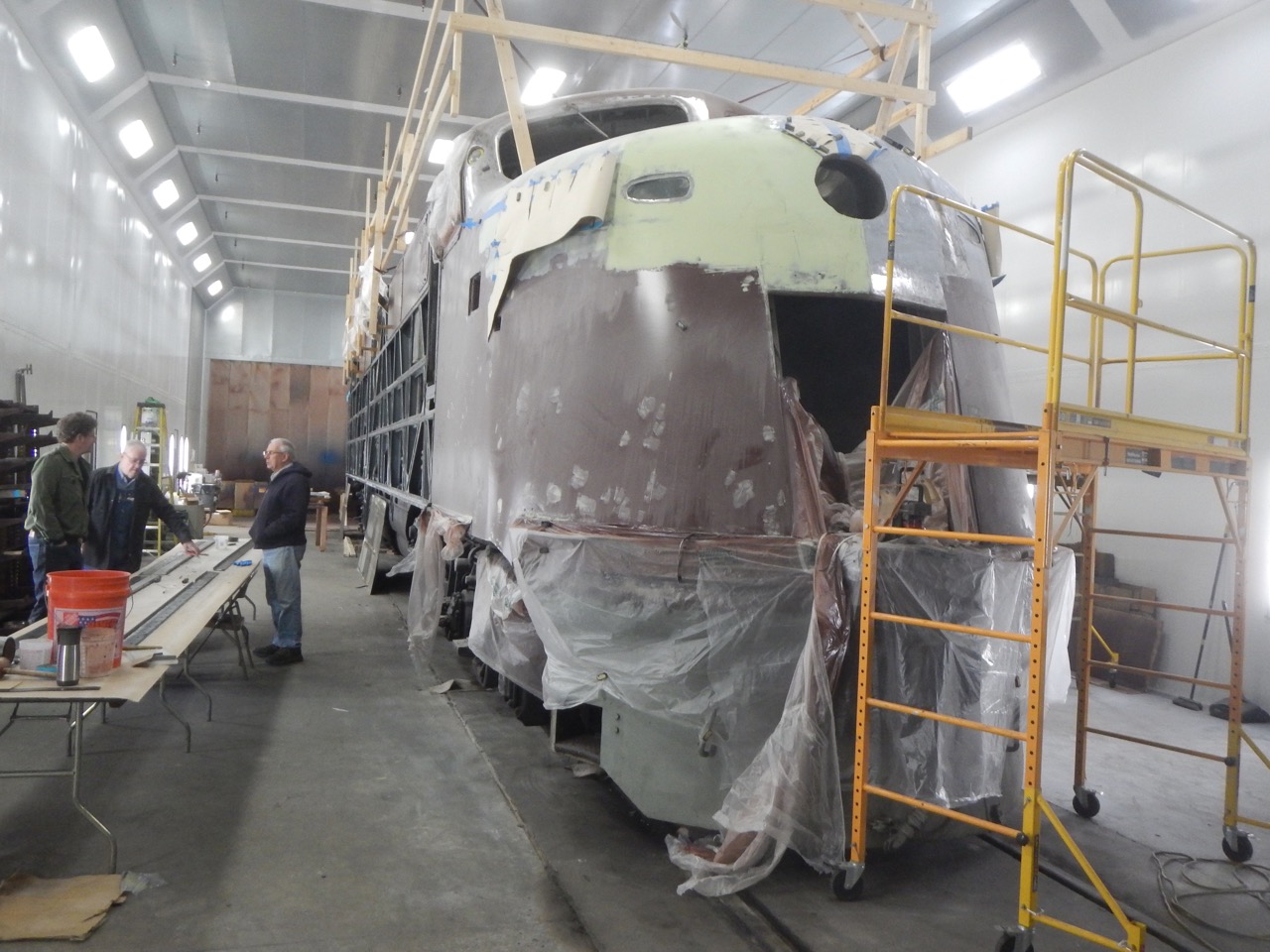When it emerges from the shop, it will sport original details later removed. According to Jamie Partridge, restoration shop manager, a composite replica of the original pilot, which featured a cowling over a retracting front coupler, and a long gone stainless steel ornamental device that wrapped around the leading edge of the hood will be included, along with stainless steel trim around the doors and windows.
At some point in the unit’s service life, the original sheeting on the body was replaced with aluminum, and the resulting electrolytic reaction with the steel frame members caused the sheeting to crumble from the inside out, Partridge pointed out. All the sheeting on both sides of the locomotive has been removed, and new sheeting is being prime painted on both sides before installation. The steel framing was needle scaled and treated with rust preventative paint. In addition, cushioning strips have been glued to the frame to insulate the sheets from the framing.
While seeking original paint, Partridge and his crew found on the rear of the locomotive, the original number 51-A in gold leaf, a detail that will be replicated. The original colors — royal blue, medium gray, and a pale yellow gold — have been analyzed and matching modern formulations found.
The restoration of No. 51, while not an operational restoration, is one of the most important projects in railway preservation today, since museum visitors will see all the original details of the locomotive that overcame the steam locomotive just as people saw it when it was delivered in 1937.















Great news to save an old EA bird! I disliked my photo of her at the Museum in 2009, so cramped and only her prominent nose accessible.
#51 was shipped to EMD along with all the EA/EB’s for “rebuild” into E8’s. Somebody at EMD realized the significance and offered the carbody to B&O for their museum! Fortunately they accepted. The Winton V-12’s are nearly unique and long since completely unsupportable. Just look at the Flying Yankee Group for the saga of trying to get a straight-8 Winton engine operable. Isn’t going to happen.
Anna, I imagine she was retired running. So I doubt it would take much to get them to turn over if her time spent outdoors through the years hasn’t done major harm to them (There’s significant corrosion throughout her; Her time in retirement hasn’t always been spent under cover in the roundhouse).
The thing is though is that these engines always had issues and there are no spare parts left to support an operational restoration. They’ve been gone from Class 1’s since the 1950’s, EMD long ago couldn’t justify the inventory taxes and scrapped their spare parts, and the few Winton 201 powered locomotives that survived longer did so by scavenging used parts for hulks.
Today, there are no new reciprocating components, no new cylinder liners, no new cylinder heads, no substitutes for most of the engine bearings and fuel injection equipment, no replacement gaskets, etc. Search the net and I believe there’s a good article by Preston Cook on the challenges involved in pursuing such a thing, even for early model 567’s.
As for what else is needed, like I said, we know that her main generators and traction motors were removed and incorporated in a new EMD E8. So all significant electrical rotating gear would require replacement.
Really the only realistic way to operate her today might be as an unpowered cab car, just for looks. Too much history would be lost to repower her with more modern and supportable diesels, and an operational restoration of her original Wintons would be impractical due to the engine situation.
NRHS Heritage Grant Program
Washington, DC Chapter, NRHS listed at IGIVE.COM.
Tom E. Dailey Foundation, Inc.
The John H. Emery Rail Heritage Trust deadline is Feb 1st, 2019.
AMAZONSMILE
Mister Ames:
Ok, will the engines turn over? If not, what would be required to make that happen? And what about the generators, motors, switchgear? What condition is that in, or are you in a position to know?
The above comments are general in nature and do not form the basis for an attorney/client relationship. They do not constitute legal advice. I am not your attorney. Find your own damn mouthpiece.
This is just plain cool!
What would be required to bring this unit back to operating condition?
The above comments are general in nature and do not form the basis for an attorney/client relationship. They do not constitute legal advice. I am not your attorney. Find your own damn mouthpiece.
Nice, Ive seen this unit at the B&O, Beautiful!!! Theyve had this for decades, why so long?
Peter, she has her Winton engines, so hardly a need for fakes. They had no reuse value for the B&O E unit that she was traded in towards, so were left in place.
Pretty cool. I like the class light in cab side pillar (“A” pillar in automobile terms.)
Great story!
I believe that that this unit could get cosmetic 201A engines, appropriate generators and steam generator. This locomotive should have gone to WMSR, with E9 engines and appropriate alternator/generators. The purists had a pure fit. But, an EA/E9 pair would have needed only a run around track. But, 1309 is eventually going to run and 51A will look nicer in the museum, hopefully indoors.
For further details, see my article on Winton and B&O relationship in Summer 2018 issue of Sentinel, quarterly journal of B&ORR Historical Society.
At a minimum, a small warehouse of Winton 201-A engine parts to get her engines running and be able to maintain them for occasional service afterwards, and replacements/substitutes for the Westinghouse main generators and traction motors that were recycled into modern E units when she got traded in.